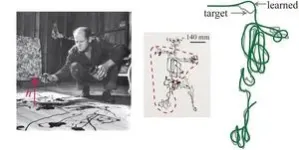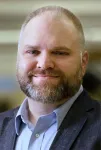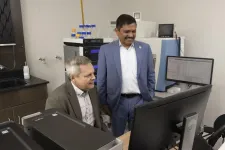(Press-News.org)
Sunflowers famously turn their faces to follow the sun as it crosses the sky. But how do sunflowers “see” the sun to follow it? New work from plant biologists at the University of California, Davis, published Oct. 31 in PLOS Biology, shows that they use a different, novel mechanism from that previously thought.
“This was a total surprise for us,” said Stacey Harmer, professor of plant biology at UC Davis and senior author on the paper.
Most plants show phototropism – the ability to grow toward a light source. Plant scientists had assumed that sunflowers’ heliotropism, the ability to follow the sun, would be based on the same basic mechanism, which is governed by molecule called phototropin and responds to light at the blue end of the spectrum.
Sunflowers swing their heads by growing a little more on the east side of the stem – pushing the head west – during the day and a little more on the west side at night, so the head swings back toward the east. Harmer’s lab at the UC Davis College of Biological Sciences has previously shown how sunflowers use their internal circadian clock to anticipate the sunrise, and to coordinate the opening of florets with the appearance of pollinating insects in the morning.
In the new study, graduate student Christopher Brooks, postdoctoral researcher Hagatop Atamian and Harmer looked at which genes were switched on (transcribed) in sunflowers grown indoors in laboratory growth chambers, and in sunflowers growing in sunlight outdoors.
Indoors, sunflowers grew straight toward the light, activating genes associated with phototropin. But the plants grown outdoors, swinging their heads with the sun, showed a completely different pattern of gene expression. There was no apparent difference in phototropin between one side of the stem and another.
The researchers have not yet identified the genes involved in heliotropism.
“We seem to have ruled out the phototropin pathway, but we did not find a clear smoking gun,” Harmer said.
Blocking blue, ultraviolet, red or far-red light with shade boxes had no effect on the heliotropism response. This shows that there are likely multiple pathways, responding to different wavelengths of light, to achieve the same goal. Upcoming work will look at protein regulation in the plants.
Sunflowers are quick learners. When plants grown in the lab were moved outdoors, they started tracking the sun on the first day, Harmer said. That behavior was accompanied by a burst of gene expression on the shaded side of the plant that did not recur on subsequent days. That suggests some kind of “rewiring” is going on, she said.
Apart from revealing previously unknown pathways for light-sensing and growth in plants, the discovery has broad relevance, Harmer said.
“Things that you define in a controlled environment like a growth chamber may not work out in the real world,” she said.
Atamian is now an assistant professor at Chapman University.
END
URBANA, Ill. — A team of animal scientists from the University of Illinois Urbana-Champaign is set to deliver a potential game changer for subsistence farmers in Tanzania: cows that produce up to 20 times the milk of indigenous breeds.
The effort, published in Animal Frontiers, marries the milk-producing prowess of Holsteins and Jerseys with the heat, drought, and disease-resistance of Gyrs, an indigenous cattle breed common in tropical countries. Five generations of crosses result in cattle capable of ...
CHAPEL HILL, N.C. – The lungs were once at the forefront of SARS-Cov-2 research, but as reports of organ failure and other serious complications poured in, scientists set out to discover how and why the respiratory virus was causing serious damage to the body's major organs, including the lungs.
An interdisciplinary COVID-19 International Research Team (COV-IRT), which includes UNC School of Medicine’s Jonathan C. Schisler, PhD, found that SARS-CoV-2 alters mitochondria on a genetic ...
A groundbreaking study published in the journal Research in Aging sheds light on the financial challenges of housing-with-health-services models for low-income older adults. The report explores strategies for ensuring the sustainability of these beneficial efforts.
The study was conducted in partnership with Hebrew SeniorLife, a Harvard Medical School-affiliated nonprofit organization serving older adults in the Greater Boston area. It drew on insights from 31 key informational interviews and three focus groups ...
The next generation of cardiometabolic biomarkers should pave the way for earlier detection of risk factors for conditions such as obesity, diabetes and heart disease in children, according to a new scientific statement from the American Heart Association published in the journal Circulation.
“The rising number of children with major risk factors for cardiometabolic conditions represents a potential tsunami of preventable disease for our healthcare system,” says the statement’s lead author Michele Mietus-Snyder, M.D., ...
A new compact, lightweight, gel-free and waterproof electrocardiogram (ECG) sensor offers more comfort and less skin irritation, compared to similar heart monitoring devices on the market.
ECGs help manage cardiovascular disease – which affects around 4 million Australians and kills more than 100 people every day – by alerting users to seek medical care.
The team led by RMIT University in Australia has made the wearable ECG device that could be used to prevent heart attacks for people with cardiovascular disease, including in remote healthcare and ...
BINGHAMTON, N.Y. -- A new drug developed by professors from the School of Pharmacy and Pharmaceutical Sciences at Binghamton University has received Food and Drug Administration (FDA) approval for the treatment of patients with Duchenne muscular dystrophy (DMD), a common genetic disease that mostly affects young boys.
DMD is the most common genetic disease. It leads to the loss of the dystrophin protein in muscle tissues, with progressive weakness and challenges with day-to-day activities. The DMD gene is the largest gene in the human genome, ...
The antibody-drug conjugate trastuzumab deruxtecan is approved for various therapeutic indications. Since March 2023, it can also be used as monotherapy for the treatment of adults with unresectable or metastatic HER2-low breast cancer who have received prior chemotherapy at this disease stage or developed disease recurrence early after adjuvant chemotherapy. Treatment with trastuzumab deruxtecan is the first approved therapy for patients with HER2-low breast cancer. The German Institute for Quality and Efficiency in Health Care (IQWiG) examined in an early benefit assessment whether the antibody-drug ...
Children and young people with attention deficit hyperactivity disorder (ADHD) use healthcare services twice as often in the two years before their diagnosis, a study by researchers at the University of Nottingham and King’s College London has found.
The research, published today in the journal Archives of Disease in Childhood shows that children with the neurodevelopmental disorder are twice as likely to see their GP, go to hospital for an admission, and even have operations, compared to children without ADHD.
The researchers say the results support the need for healthcare professionals to consider a potential diagnosis of ADHD in children who ...
In the late 1970s, the relationship between the c-Src gene and cancer was discovered. The first oncogene was identified.
Since then, c-Src has been found to be overactivated in half of colon, liver, lung, breast, prostate and pancreatic tumors, but its function is not yet fully understood.
CNIO researchers have now discovered that this oncogene is capable of 'self-activation', by means of a previously undescribed molecular mechanism. This finding has implications for the development of new drugs.
In ...
Philadelphia, October 31, 2023 – Heart attacks, or acute myocardial infarction (MI), are one of the leading causes of death worldwide. The newly released Canadian Cardiovascular Society Classification of Acute Myocardial Infarction (CCS-AMI) appearing in the Canadian Journal of Cardiology, published by Elsevier, presents a four-stage classification of heart attack based on heart muscle damage. This work by a group of noted experts has the potential to stratify risk more accurately in heart attack patients and lays the groundwork for development of new, injury-stage-specific and tissue ...






